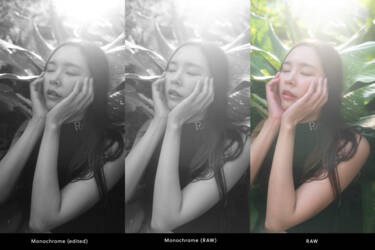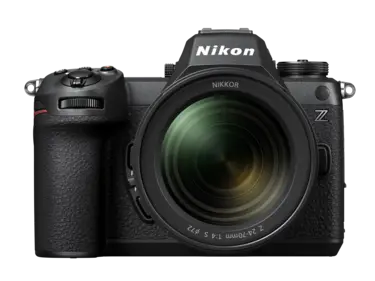Better portraits faster

The Nikon Z9 firmware update delivers a host of new opportunities for portrait photographers. Discover how they can help you…
From softening skin to elevating skin tones, the Nikon Z9’s v.5.0 firmware update, plus the v.5.10 and v.5.20, introduces a bounty of powerful portrait settings, offering photographers greater creative control in-camera. Known for his evocative and atmospheric style, portrait photographer and Nikon Creator Dhan Limwattana puts these modes to the test, sharing how the new tools can refine workflow and enhance portraits.
Nikon magazine: Tell us about the new update. How can it help portrait photographers?
Firmware updates aren’t just for fixing bugs. They often come with new features that unlock creative possibilities, and the v.5.0 firmware update introduces many exciting enhancements for portrait photography in particular. For example, the High Dynamic Range Portrait mode and the improved Skin Softening function allow you to render skin tones soft and natural, directly in camera, eliminating the need for time-consuming post-processing. Especially under natural lighting conditions, these settings will elevate your portraits, capturing the mood and details effortlessly.
What portrait mode is your favourite?
For me, the Monochrome Mode is definitely my go-to choice when photographing in black and white. What makes this mode stand out is how much control it gives me over the visual result right from the start. With options such as colour filters, contrast, sharpness and tone adjustments all available during the shot, I can shape the mood and contrast of the image on the fly without getting lost in post-processing later.
How does it compare?
I prefer Monochrome over Flat Tone and Deep Tone because it delivers bold, clear images straight out of the camera. I find that Flat Tone requires more work in post-production, especially when you want to finely tune all those subtle details. As for Deep Tone, it tends to be a little too intense for the kinds of scenes I typically photograph; the contrast, for me, can often feel a bit over the top. The Monochrome setting gives me exactly what I need – more subtle control and balance with less hassle. I’ll still reach for Flat Tone or Deep Tone when a more detailed post-editing approach or intense dramatic effect is called for but, for everyday work, Monotone is the perfect middle ground. It strikes a great balance between control and efficiency.
How can portrait photographers get the most out of Monochrome mode?
By experimenting with different filters during the shot, I can determine the tones and overall feel right away. This efficiency saves me a lot of time in the editing phase. Also, it’s about getting the light and shadows right as I shoot, so I can start crafting the mood and atmosphere I envision without wasting time getting caught up in complicated adjustments later. This allows me to work faster and focus more on the creative process.
From left to right: Rich Tone Portrait (edited), Rich Tone Portrait (RAW), no filter. 85mm, 1/200 secs, f/2.8, ISO 250, ©Dhan Limwattana
What other modes would you advise portrait photographers to use?
Rich Tone Portrait mode! It’s essential for bringing more depth to your portraits and is, in my opinion, one of the standout features. It’s designed to provide vibrant colour reproduction and refined contrast control. This mode is particularly useful for portraits in complex lighting conditions, such as outdoor shoots with shifting light. The results are so polished straight out of the camera that minimal editing is needed. It’s a great way to elevate your portraits while saving time in post-production.
How do you enhanced your portraits with the modes?
I love to photograph new models from the country I’m visiting, as each place has its own unique qualities. What made this shoot (below) particularly interesting was that the models in Thailand were accustomed to different poses. For this image below, I used the Rich Tone Portrait mode, as it helps with smoother transitions in lighting, subtly smooths skin imperfections and enhances the midtones, creating more vibrant and natural portraits. The mode delivers ideal exposure for skin tones, resulting in a flattering outcome without harsh contrasts. Personally, I’m really happy with this image, as I was able to integrate the model seamlessly with the natural surroundings. The environment plays a big role, with the model as the focal point, and the composition is like a strong triangle, bringing a sense of calm to the image.
From left to right: Monochrome (edited), Monochrome (RAW) and no filter. 35mm, 1/200 secs, f/2.8, ISO 500, ©Dhan Limwattana
Taken in the heart of Benjakitti Park, a lush green space in Thailand, I wanted to capture its tropical atmosphere. The shot was taken during sunset when the light was quite harsh, so I placed the model among the plants and envisioned the scene in black and white with a touch of grain, aiming for a vintage film look. Switching to the Monochrome mode allowed me to instantly see if the image matched what I had imagined. I could evaluate the depth, midtones and highlights directly in-camera. As someone inspired by classic black-and-white films, I sometimes feel the need to create images with that same retro aesthetic, and this was one of those moments.
From left to right: Rich Tone Portrait (edited), Rich Tone Portrait (RAW) and no filter. 75mm, 1/200 secs, f/2.8, ISO 125, ©Dhan Limwattana
This photo captures how movies often depict Thailand or Asia: small street food carts in the big city and people wearing straw hats. It may be a bit of a cliché but, from a photographic perspective, it’s such a great subject to capture. I used the Rich Tone Portrait mode as it enhances the image just enough, making certain colours and details more vibrant and dynamic. What makes this image special is the composition. The foreground features an unassuming tree, the midground centres on the figure who stands out vividly and, in the background, the cars all head in one direction while the person walks against the traffic flow – almost like a ghost. It’s an amusing little detail, but entirely normal in Thailand, which adds to the charm of the photo.
From left to right: Rich Tone Portrait (edited), Rich Tone Portrait (RAW) and no filter. 43mm, 1/320 secs, f/2.8, ISO 500, ©Dhan Limwattana
I wanted to photograph a shop full of intricate details, with a person included to complete the scene. After a while, I managed to get exactly what I was looking for. The image was taken in Bangkok’s Chinatown area, where many shops sell car parts and other metal goods. The Rich Tone Portrait mode helped harmonise the many small details and vibrant colours, bringing a balanced look to the frame. What makes this image stand out is the woman’s gaze directly into my camera. In Thailand, people didn’t mind being photographed at all, which I found refreshing.
Left to right: Monochrome (edited), Monochrome (RAW) and no filter. 35mm, 1/15 secs, f/5.6, ISO 100, ©Dhan Limwattana
I often find myself drawn to Bangkok’s vibrant Chinatown, Yaowarat, where so much is happening. It’s a place where crowds converge and at certain times it can feel like being packed in a sardine can – a fascinating experience from a photographic perspective. Here, I wanted to capture that energy and chaos, so I used a slow shutter to emphasise the sense of motion. To keep the focus on the movement, I chose Monochrome mode. This stripped away the distractions of colour and directed attention solely to the interplay of motion and the environment – the essence of the scene as I experienced it.
Dhan’s top tips for perfect portraits:
Rely on autofocus for dynamic portraits
The improved autofocus is a real game-changer. You can rely on it for capturing action-packed portraits or dynamic poses because the system ensures precise and stable focus, even in fast-paced scenarios. With its speed and accuracy, you don’t need to worry about missing shots.
Maximise your lens sharpness
Achieve the best sharpness from your lens by avoiding its widest aperture. Instead, stop down by two stops to find the ‘sweet spot’. For example, if you’re using an f/1.8 lens, shoot at f/4 for optimal sharpness and image clarity.
Switch seamlessly for hybrid shoots
A practical new feature of the update is the ability to save separate settings for photo and video modes. This means you can transition between the two without readjusting your settings every time. This functionality is especially handy for portrait sessions that include short video clips, such as capturing your model’s movements or interactions.
Stay up to date with the latest in firmware here, including the v.5.10 and now the v.5.20, which brings a new shutter mode to the Z9, among other updates.
More in Technology and Know-how
Featured products
Latest in firmware

Unlock greater creativity


























